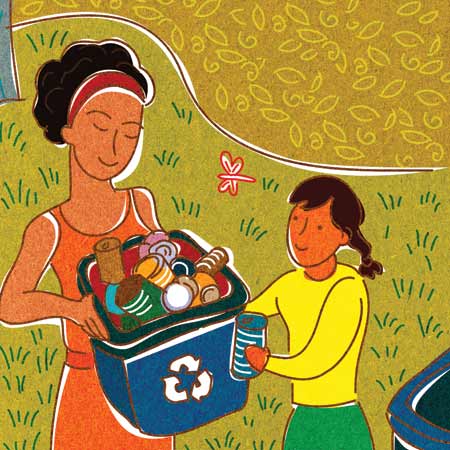
(Photo courtesy Shutterstock)
Cling … Clang … Clank. From inside my apartment, I winced at the noise my parents were making as they sorted bottles and cans out on the cramped balcony. With as much enthusiasm as I could muster, I called to my mother in Chinese, “How many do you have this time?”
“Eight hundred and six pieces, that’s $40.30!” she answered. “That makes it $309.55 in total — a decent month’s salary back home!”
I’d been living in my West Los Angeles apartment for a little over four years when my parents came for a six-month visit from the town in northeastern China where I grew up. Just a few weeks into their stay, my mother had appointed herself CFO of recycling. I’d casually mentioned that the plastic water bottle and aluminum can they’d noticed on the curb were worth 5 cents each. I had no idea that simple revelation would open such a can of worms —“golden” worms as far as my parents were concerned.
For the next several months, my building endured the clutter and clamor of my parents’ enthusiastic recycling. At dinnertime, Mom and Dad took turns recounting a list of perfectly usable things they had seen being thrown out that day. When their stay with us ended, I must confess that I felt free and relieved (and then guilty). I suspect my neighbors noticed their absence immediately. My balcony reverted to its role as a tiny garden.
Little did I know, though, that only a few months later I would be cluttering that balcony right up again and informing my parents that they had inspired me to start a recycling fundraiser at my daughter’s school. I named it the Green for Green program. To date it has brought in — bottle by bottle, can by can — more than $15,000.
When I was growing up in China, parental involvement at school was limited to attending parent-teacher conferences to discuss academic issues. Schools were free but with very limited resources (no library, gym, or science labs) and huge class sizes: up to 60 students. Students helped clean and make simple repairs. Schools operated within their means, and fundraising didn’t exist.
By the time I had a daughter of my own and she began school, I had lived in America for six years and become an American citizen. Although I considered myself pretty well assimilated, I was confused and skeptical when I first heard that I was expected to raise funds for the school. If American public schools are free, how come they keep asking for money? While fundraising for public school was a foreign concept to me, recycling was not. Wastefulness (langfei in Chinese) has been considered a vice since the earliest Chinese cultures. My parents, like most Chinese people of their generation, use everything to death, beyond the point of any possible salvage, and then they still save it just in case. Reduce, Reuse, and Recycle was a principle of survival. One of the first children’s rhymes I learned was, “Every grain of rice represents a drop of farmer’s sweat.”
During years of strict rationing in the 1970s, my mom even saved her shoelaces, unraveling them into yarn to knit mittens for me. Many of my clothes were altered hand-me-downs from my mom, aunts, and grandmother. Every scrap of cloth was used as a patch, a doll’s dress, or a rag. Dogs and cats ate people’s leftovers, and restaurants raised pigs in the backyard to feed on customers’ leftovers. When a junk collector came through the neighborhood with a wheelbarrow, chanting “Shou po lan!” (“Junk collection!”), my neighbors would chase him down with saved-up cardboard, paper, glass, metal — and sometimes even hair — to exchange for money. We went to the market with our own baskets and carried our grains and flour home in cloth bags made from used bedsheets.
When I first arrived in the U.S., I was amazed by garage sales and what they suggested: waves of new purchases rolling in, and waves of old purchases, now unwanted clutter, rolling out. Although many conscientious Americans make an effort to recycle at home, I have seen little public infrastructure set up here to make it as easy as consuming and wasting — not even, to my astonishment, in schools. We sometimes seem to be too wealthy for our own good.
But economic setbacks hit us too. During the recent economic recession, my daughter’s school, the Los Angeles Center for Enriched Studies (LACES), lost hundreds of thousands of dollars in state and federal support, including $300,000 in Title I funding (earmarked to help schools with a large percentage of students from low-income families).
I felt heavy pressure to help raise funds for my daughter’s school. At the same time, I have long felt strongly about environmental education. How could I get the whole community excited about “Reduce, Reuse, Recycle” during such a stressful and cash-strapped time? That’s when it hit me: how about uniting the two? LACES has more than 1,600 students, teachers, and staff. If my two elderly parents could raise $300 in six months from recycling, why couldn’t our school multiply that number by at least 800?
And so I approached the president of the LACES parent organization. She put me in touch with key adults: the principal, the plant manager, the school police officer, the student leadership teacher, and a few motivated parents. I found a recycling center a mile away from LACES, and its manager agreed to pick up our recyclables at our school. I ordered more recycle bins from the city, got free stickers and posters from calrecycle.ca.gov, and wrote a speech to motivate parents and teachers. The LACES principal, Harold Boger, authorized me to create and manage a Green Team page on the school’s website. I recruited volunteers at parent meetings and created an account at signupgenius.com to manage scheduling.
Next, I went to talk to the students. The leadership students at LACES are eloquent, confident, and academically successful. They have been hearing the “Reduce, Reuse, Recycle” slogan since they were in kindergarten, and they were eager to take responsibility and lead a change. However, they wanted to take charge of the outreach themselves. So we agreed the parent team would simply provide the materials and arrange to haul loads to the recycling center to redeem them.
After all that work, our first two trips to the recycling center yielded $114. I went back to the drawing board. My committee and I organized a day for students and parents to bring bottles and cans directly to school. We called it the Green for Green drive. The first one raised only $145. But I scheduled more drives. With each one, the numbers started to look better: $145 … $400 … $481. Now we were getting somewhere!
We kept improving the system. We put locks on the campus recycle bins and cut bottle-size holes on the top of each bin so students could drop bottles in and scavengers couldn’t take them out. I kept on campaigning, with heartfelt pleas, educational and funny YouTube video clips, and poems. We scheduled student assemblies. I got a parent to donate a large banner to hang in front of the school building. I went to neighborhood council meetings. The principal added a reminder about our Green for Green drives to his weekly, automated phone calls home. I made a math-themed slogan: 1,666 students x 12 bottles or cans x $.05 = $1,000.
The more success we had, the more people joined our team. Eventually, we began to save, crush, sort, and bag returnables like a well-oiled machine. Today, LACES teachers keep boxes in their classrooms for bottles and cans. Leadership students collect recyclables and store them in locked bins. Parents collect at their offices and sporting events. We’re working on getting donations from a local office building. On many occasions LACES parents have told me about their own cluttered balconies and garages and how they no longer see litter, they see money.
Getting parents together to share some dirty work at the school twice a month has also turned out to be a marvelous community-building exercise. A year ago, my daughter’s school friends told her they felt weird bringing their used containers to school. Now, I see them helping unload bags from their parents’ cars as they are dropped off at school. Hundreds of people — parents, students, and occasionally people from the neighborhood — bring bags of returnables with them from all over the city. Twenty parent volunteers sort and bag, chatting about the latest news at the school and meeting new friends. In an hour, a pile of plastic bottles, aluminum cans, and clear, green, and brown glass bottles are neatly sorted by material type and bagged for pickup.
Since the LACES Green for Green program started in Fall 2011, LACES students and parents have raised approximately $15,500 for the school and recycled about 75,000 pounds of waste. I know that $15,500 is a drop in a bucket, but for us it means 5 percent of the funding for over 20 programs, including our school choir, Math Mania, general scholarships, technology support, school buses, and nurse days. I take great satisfaction in knowing that this modest program motivates the community to extract money from waste and that everyone, no matter their financial means, can contribute.
Looking back, I see that although I spearheaded the charge, success requires community. I believe that most people want to contribute, but it’s a lot more motivating when you feel that you belong to something bigger, that your effort is matched by the others in the community, and that the result is multiplied. During the past two years, news of Green for Green’s success has spread to other school communities through word of mouth. I have received emails and phone calls from parents at other schools asking to share what wisdom I have gained. I’m proud to think that the LACES recycling effort may have snowballed.
I used to laugh at my parents’ frugality when I was young, having never experienced starvation or rationing like they did. I laughed again at their recycling project during their six-month visit here. Now I laugh at myself for having benefited from their wisdom. They may never have intended to influence anyone beyond their family, but their small effort has led to bigger change, one that inspires family, friends, children, co-workers, and even strangers.
Who knows what they’ll inspire on their next visit—a solution to L.A.’s water shortage?
Become a Saturday Evening Post member and enjoy unlimited access. Subscribe now



